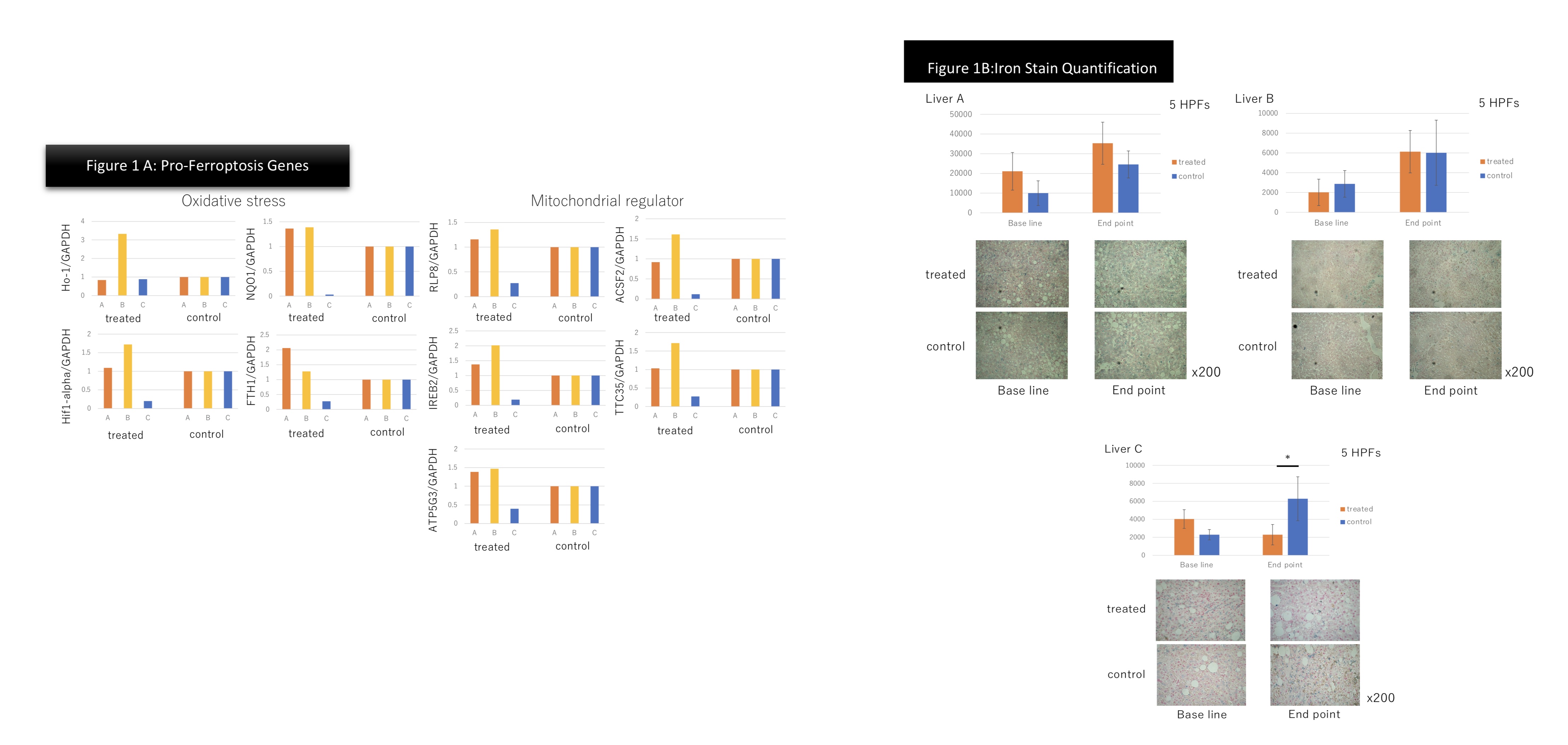The Role Of Ferroptosis In Modulating Ischemia Reperfusion Injury(IRI) Gene Expression In Marginal Donor Livers(MDLS) Using The Novel Protect Normothermic Perfusion Pump
1Surgery, Saint Louis University, Saint Louis, MO, 2Pediatrics, Saint Louis University, Saint Louis, MO, 3Pathology, Saint Louis University, Saint Louis, MO
Meeting: 2022 American Transplant Congress
Abstract number: 9033
Keywords: Donors, marginal, Ischemia, Liver grafts, Liver transplantation
Topic: Basic Science » Basic Science » 14 - Ischemia Reperfusion
Session Information
Session Time: 5:30pm-7:00pm
 Presentation Time: 5:30pm-7:00pm
Presentation Time: 5:30pm-7:00pm
Location: Hynes Halls C & D
*Purpose: Severe IRI can impair liver allograft when using MDLs and accounts for high discard rates. We tested iron chelators to reduce ferroptosis and IRI. We hypothesized that such changes accompany ferroptosis modulation of gene expression, highlighted below.
*Methods: Discarded MDLs were split into right and left lobes and perfused using PROTECT normothermic perfusion pump. One lobe was treated with Deferoxamine (DM), other acted as an internal control. Hourly biopsies were performed. We compared iron content and pro-ferroptosis gene expression between the 2 lobes. Perls Prussian blue(PPB) analysis and Image J(IJ) for Iron quantification.Ho-1, Hif-alpha, NQO1, FTH1 and mitochondrial regulator genes; RLP8, IREB2, ATP5G3, ACSF2, TTC35 were assessed.
*Results: 3 DCD MDLs were split (A,B,C). Two of the three livers (A,B) showed a marked increase in the expression of pro-ferroptosis genes. Liver A treated lobe showed fold changes of 0.84, 1.09, 1.36, 2.06, 1.16, 1.40, 1.39, 0.91, and 1.03 for Ho-1, Hif-alpha, NQO1, FTH1, RLP8, IREB2, ATP5G3, ACSF2, and TTC35, respectively. Liver B showed fold changes of 3.32, 1.72, 1.39, 1.28, 1.36, 2.01, 1.47, 1.61, and 1.71 for Ho-1, Hif-alpha, NQO1, FTH1, RLP8, IREB2, ATP5G3, ACSF2, TTC35, respectively(FIgure1A). For livers A and B, Iron content increased in both the treated and untreated lobes. Iron quantification resulted in a 1.4- and 3-fold increase for livers A and B treated lobe, consistent with the increase in ferroptosis markers, and indicative of minimal chelation(Figure2B). For Liver C, the treated lobe had a decrease in ferroptosis markers. Fold were 0.89, 0.20, 0.03, 0.27, 0.27, 0.19, 0.40, 0.12, and 0.27 for Ho-1, Hif-alpha, NQO1, FTH1, RLP8, IREB2, ATP5G3, ACSF2, TTC35, respectively(Figure1A). The decrease in ferroptosis marker expression was consistent with the reduction in iron content of 1.8 fold in the treated lobe, which is correlated to inhibition of pro-ferroptosis genes (figure 1B).
*Conclusions: Although not all treated lobes achieved chelation of Iron with DM treatment, the treated lobe C that demonstrated iron chelation, as shown by iron staining, showed a decrease in the expression of Pro-ferroptosis genes and IRI. . This result underscores the importance of interrogating ferroptosis pathways to explore therapeutic targets of IRI.
To cite this abstract in AMA style:
Nazzal MD, Kurashima K, Bettag J, Chen A, Bruno S, Nagarapu A, Nispen JVan, Krebs J, Teckman J, Carpenter D, Hermelin D, Varma C, Jain A. The Role Of Ferroptosis In Modulating Ischemia Reperfusion Injury(IRI) Gene Expression In Marginal Donor Livers(MDLS) Using The Novel Protect Normothermic Perfusion Pump [abstract]. Am J Transplant. 2022; 22 (suppl 3). https://atcmeetingabstracts.com/abstract/the-role-of-ferroptosis-in-modulating-ischemia-reperfusion-injuryiri-gene-expression-in-marginal-donor-liversmdls-using-the-novel-protect-normothermic-perfusion-pump/. Accessed December 25, 2025.« Back to 2022 American Transplant Congress

